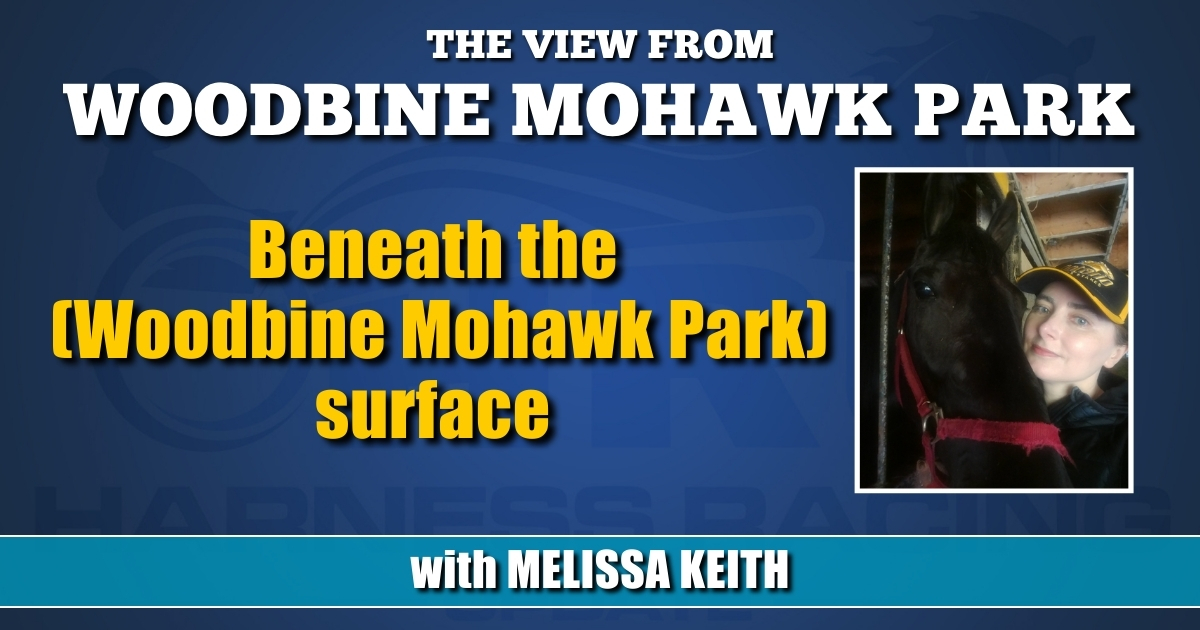

Beneath the surface
Former WMP racing surfaces manager Mark Horner talks winter track maintenance.
by Melissa Keith
Woodbine Mohawk Park cancelled scheduled availability for training on Thursday (Dec. 28) because of weather, with the next training day now Saturday (Dec. 30). Racing was delayed for essential track maintenance Saturday (Dec. 23), with race 1 post time moving from 7:10 p.m. to 7:50 p.m. and then 8-8:10 p.m. The surface was still sloppy with a two-second variant, but all 11 races went ahead.
Mark Horner is a full-time horseman who consults on standardbred racing surfaces by request. He worked as interim manager of racing surfaces at Woodbine Mohawk Park in 2021, following the retirement of long-time Woodbine Entertainment employee Rick Blackmore. Although he had worked for Woodbine since 2002, Blackmore became WMP manager of racing surfaces in spring 2018, when the Campbellville, ON track began hosting year-round harness racing.
Horner said he mostly focuses on his farm track in St. Marys, ON today, as he keeps his racing stock and young horses in training there.
“I’ve always had my own track,” Horner said. “When I took it over, I think I was 20 years old, so for 34 years… We have one renter now, Bud Sinclair. He’s only got a couple of horses.”
Horner is Standardbred Canada’s Ontario Region track director, as well as chair of The WFA Raceway Corporation and a member of the Western Fair Association board of governors. He said that his responsibilities do not include maintaining the racing surface for The Raceway at Western Fair, London, ON.
“Doug Lilley is the track superintendent; I’m a resource for him,” Horner said.
The 54-year-old trainer/driver has invaluable knowledge on that front. He told HRU that whether getting his own small track or the seven-eighth-mile WMP surface ready, the principles remain the same.
“Fundamentally, yeah,” he said. “At the farm track, I’ve got a 10-foot conditioner, and there [Mohawk], you’ve got three 12-foot conditioners, so you’re just covering more ground, but the end result’s the same. The timing is much different: For training, we’re training in the morning [at his farm], so I can set it up today for tomorrow, but when you’re racing, at night or sometimes in the afternoon, you set it up the day of for the night [or afternoon] of racing.”
There is also an obvious difference in scale when it comes to Mohawk.
“It’s a big task, that’s for sure, but they’ve got lots of equipment and lots of crew, and you’ve just got to do what the weather tells you to do on that particular day,” Horner said. “Mohawk is great because… there’s 200 tons of material on hand all the time, so they can resurface every day if they choose to. With the other tracks, it’s difficult to get material on hand, especially through the winter… Mohawk has the ability to store a large volume, and Western Fair now has a hut up in the infield to store and keep it dry.”
The Mohawk racing surface is “trap rock” brought in from Peterborough, ON, which Horner described as “great material to work with, but expensive.”
He said trap rock’s distinct color plays an important role in the visibility of racing.
“If you hold it in your hand, it’s a light tinge of blue, but when you add water to it, it turns black…” Horner said. “It shows up better on the TV. When it’s nice and dark, the horses stand out.”
Winter track conditioning presents a time-sensitive challenge that comes down to the freezing point, said Horner.
“It’s all about the temperature zero [degrees Celsius; 32 degrees Fahrenheit]…” he said. “You have to freeze-dry [the surface], and it can change. A track can go from slop to powder-dry in 30 minutes when the temperature plummets. Say you’re setting up for a night of racing, a lot of times in the wintertime it will hit zero [Celsius] at 5 o’clock when the sun goes down, and then the temperature starts to drop.”
Variables change moment to moment, which Horner said calls for flexible response.
“Mother Nature will do that to you, and you’ve just got to work with her, not against her,” Horner said. “When it goes up over zero, [the surface] turns to mush; when it goes under zero, it will freeze rock-hard in a matter of minutes… When you go to race at night in Ontario, the temperature typically will hover at zero or plus 1 [degree Celsius; 33.8 Fahrenheit]; plus 2 [degrees Celsius] and it will be soft. When the temperature drops, you’re just waiting… When it’s cloudy, sometimes that will insulate the heat, but on a clear night, it will freeze quicker. You’ve got to be a full-time weatherman.”
He said the WMP track maintenance crew responded well to get the track ready Saturday night, when the temperature stayed 2 degrees Celsius (35.6 degrees Fahrenheit) throughout the card.
“That’s the ability that they have, that a lot of tracks don’t,” Horner said. “They just put the graders out there and take the top off [the track] and resurface… just put new, dry material on and away you go. Mohawk’s a different beast. It’s a huge piece of dirt. It takes time to get it done.”
He observed that early winter 2023-24 was more difficult for track maintenance than snowy Decembers past.
“It’s an El Niño winter,” Horner said. “The tracks haven’t froze and you’ve got moisture on top, so it’s just soggy. A hard rain is always better than a mist, because a mist or a soft rain just lays on it. [The racing surface] absorbs it like a sponge, and then you get the horses punching through. It’s a very technical job, believe me.”
The importance of track maintenance to horse and driver safety cannot be overstated.
“Every track has their own demons,” Horner said. “A
track always has a memory. So, what you do to it today, the track will remember it tomorrow. What I mean by that is, if you have a big water spill from the water truck, or the grader gouges the base, or you’re using material that’s not sufficient for the ground that you want to make it… The keys to a track are weather, material and maintenance… You’ve got to move, pivot, and adjust. If one piece of equipment isn’t giving you the wanted outcome, you’ve got to switch to the screen or maybe some guys like using the chain harrow instead of the conditioner.”
At Mohawk, preparing the surface for winter use takes coordination.
“You could have five rigs out there,” said the track’s former manager of racing surfaces. “The water truck, three drags, a multitude of tasks happening all at once. Mohawk’s a big piece of dirt, so to get all the way across it before it freezes up when you’re freeze-drying is challenging. There are spots where you can go and can’t go. Take a 5,000-pound conditioner, or 6,000 pounds at Mohawk, and then put them on mud and hope they don’t get stuck.”
Horner said he would like to see a formal program for Ontario horsepeople to learn about year-round track maintenance. He said his skills remain in demand, on a freelance basis.
“Since I left Mohawk, I’ve been consulting at different tracks,” he said. “I helped Hanover [Raceway, in Hanover, ON] with theirs this past summer, setting it up… They wanted it banked a little more, and just graded and then a new surface on it… I’ve been out to Century [Downs, in Rocky View, AB] a few times… Just more or less kind of educating the crew [at Century], and it’s a difference in [track surface] material… A perfect surface is all about material.”














